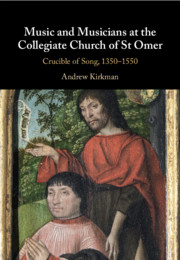Book contents
- Music and Musicians at the Collegiate Church of St Omer
- Frontispiece
- Music and Musicians at the Collegiate Church of St Omer
- Copyright page
- Epigraph
- Contents
- Figures and Map
- Acknowledgements
- Note on Editorial Policy, Currency and Dates
- Prologue
- 1 The Maîtrise
- 2 Identities and Career Patterns
- 3 Masters and Master Singers
- 4 The Organs
- 5 The Bells
- 6 Loose Canons? Music and the Craft of Ecclesiastical Power
- Epilogue
- Appendix Documents Pertaining to the Suppression of Benefices for the Upkeep of the Master and Choirboys (See )
- Bibliography
- Index
1 - The Maîtrise
Published online by Cambridge University Press: 31 August 2020
- Music and Musicians at the Collegiate Church of St Omer
- Frontispiece
- Music and Musicians at the Collegiate Church of St Omer
- Copyright page
- Epigraph
- Contents
- Figures and Map
- Acknowledgements
- Note on Editorial Policy, Currency and Dates
- Prologue
- 1 The Maîtrise
- 2 Identities and Career Patterns
- 3 Masters and Master Singers
- 4 The Organs
- 5 The Bells
- 6 Loose Canons? Music and the Craft of Ecclesiastical Power
- Epilogue
- Appendix Documents Pertaining to the Suppression of Benefices for the Upkeep of the Master and Choirboys (See )
- Bibliography
- Index
Summary
The maîtrise (or choir school) was the crucible of late medieval polyphony and chant: a first stepping stone on the progress to ecclesiastical careers and, more specifically, to musical careers within the church. It was also the seedbed for most composers of note in the fifteenth and sixteenth centuries. Hence the training and social context it provided are crucial to understanding the shape and role of music in the period. The chapter addresses both the progress in and the reasons – theological and practical – for the cultivation of choirboys, and especially the changes of perspective that led to the vastly increased investment in their training and accoutrements. A signal element here is their role in private foundations paid for by individuals (especially church canons) for the welfare of their souls, and in the increasing elaboration of such foundations including chant and, particularly, polyphony.
Keywords
- Type
- Chapter
- Information
- Music and Musicians at the Collegiate Church of St OmerCrucible of Song, 1350–1550, pp. 22 - 65Publisher: Cambridge University PressPrint publication year: 2020

